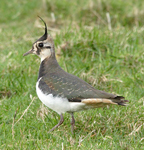Lapwing
 The Northern Lapwing is also known as the peewit in imitation of its display calls, its proper name describes its wavering flight. Its black and white appearance and round-winged shape in flight make it distinctive, even without its splendid crest. This familiar farmland bird has suffered significant declines in the last 25 years and is a protected in the United Kingdom because of the importance of its wintering population.
The Northern Lapwing is also known as the peewit in imitation of its display calls, its proper name describes its wavering flight. Its black and white appearance and round-winged shape in flight make it distinctive, even without its splendid crest. This familiar farmland bird has suffered significant declines in the last 25 years and is a protected in the United Kingdom because of the importance of its wintering population.
The lapwing mainly breeds on farmland, especially among crops sown in spring which are adjacent to grass and bare land. Also on pasture, wet grassland and marshes.
It winters in flooded grassland, estuaries, coastal wetlands, short grassy fields and ploughed fields.
Lapwings are found on farmland throughout the UK particularly in lowland areas of northern England, the Borders and eastern Scotland. In the breeding season they prefer spring sown grains and root crops, permanent unimproved pasture, meadows and fallow fields. They can also be found on wetlands with short vegetation. In winter they flock on pasture and ploughed fields.
What does a lapwing sound like?
The lapwing’s call is a wheezing 'pee-ee-wit'; their song includes 'eyuweep' and 'weep-weep' phrases.
There are local tales surrounding the lapwing but they are not in agreement - some speak of the bad luck and death that seeing one brings but I prefer to speak to the farmer who knows that in this cold climate the call of the lapwing is the first herald of spring.
When other birds still shun the area for warmer southern lands and the hail and sleet wash over the moorlands pushed by the cold northern winds and winter seems to last forever it is the call of the lapwing that tells us the end is near and the new shoots and warmth are on their way. The piebald coloring is also important as her very features speak of darkness into light to reflect this change.
The poetic meaning of the lapwing is "disguise the secret" because she hides her nest so successfully. Some say that Solomon invented the language of the birds, and the lapwing was the first to use it.
A little bird told me ... this expression refers to an implied secret or private source of knowledge. The origin of the expression is attributed to the lapwing...All the birds of the air were summoned to King Solomon but the Lapwing did not appear. Later the Lapwing explained that he had been with the Queen of Sheba and that she had indicated that she intended to visit Solomon. The King began to make preparations for the visit; in the meanwhile the Lapwing flew to the Queen and told her that the King had a great desire to see her. As history records, such a meeting did take place, but the role of the Lapwing is less clear.
In the Welsh myth Cad Goddeu, a rare white roebuck is stolen from Arawn of Annwn, symbolic of the soul's journey into death. In Welsh mythology, Arawn was the Lord of the Underworld, which was called Annwn.
Some of the more prominent myths about Arawn include the incident in which Amaethon stole a dog, lapwing and a white roebuck from Arawn, leading to the Cath Godeau, (the Battle of the Trees) which Arawn lost to Amaethon and his brother, Gwydion.